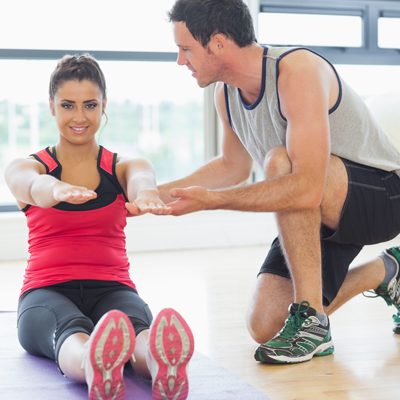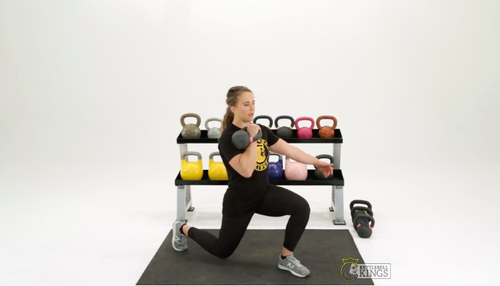The gluteal muscles are the group of muscles in the body that make up the buttocks. The three gluteal muscles are the gluteus maximus, gluteus medius, and gluteus minimus, with the gluteus maximus being the largest muscle in the body. Since the glutes constitute the biggest muscle group in the body, they demand lots of energy to operate.
Weak glutes increase the chance of hamstring, groin, and knee injuries. Weak glutes also contribute to back injuries, as lack of glute strength puts excess demand on your lower back muscles to perform any lifting. The glute strength built by kettlebell training provides with necessary support for your entire body.
Workout Instructions
This workout features five kettlebell exercises that strengthens your glutes. As the body’s primary hip extensor muscles, strong glutes help athletes become more explosive and efficient by encouraging correct movement patterns. By creating strong glutes through the kettlebell exercises in this workout, you can improve athletic performance and daily movements, including jumping higher, running faster, and lifting heavier.
If you are a beginner, start with a kettlebell weight of 18 to 25 pounds. A kettlebell that weighs 35 to 53 pounds would be well-suited for lifters of intermediate to advanced abilities.
Perform a few warm up exercises to engage your glute muscles before starting this kettlebell workout, such as hip bridges and bird dogs. Warming up will elevate your heart rate and boost blood flow to your muscles, priming your body for movement. Warming up will also reduce the risk of injury and enhance your potential to develop glute strength.
Farmer Carry
Areas Worked: Core, Arms, Upper Back
- Start with the feet about hip width apart and a kettlebell to the outside of either foot. Hinge at the hips to grab hold of the kettlebell handles. Set the back and shoulders in place by pulling the shoulders down and away from the ears. Ensure the back is flat and the shoulders are at or above hip level.
- Drive through the feet to come up to a standing position, loading the hamstrings and fully extending the hips by contracting the glutes at the top. Keep the bells to either side of your body.
- Walk with the bells for the desired amount of time. Maintain good posture throughout by pulling the shoulder blades together and engaging the core.
- Hinge at the hips, using your deadlift form to bring the bells back down to the floor.
- Complete three sets.
Single Leg Kettlebell Deadlift
Areas Worked: Hamstrings, Glutes
- Begin in a standing position holding a kettlebell at your side.
- Hinge at the hips as you send the leg on the side of the it behind you. Go as low as you can while maintaining a neutral spine. The lifted leg should counterbalance the chest coming down. The standing leg should have a microbend in the knee.
- Drive into the heel of the standing leg and contract the glutes to return to standing position.
- Perform 5 sets of 6 reps on each side.
Kettlebell Goblet Squat
Areas Worked: Hamstrings, Quads, Glutes
- Start standing with the kettlebell in front of your chest, hands on either side of the handle in the goblet position.
- Squat down, reaching the hips back and bringing the elbows to the inside of the knees (this will help you determine correct depth and keep your chest up).
- At the bottom of the squat position, ensure the spine is neutral, chest is up, and tailbone is not tucked under. Depth may vary depending on your flexibility.
- Push the floor away to drive back up to the standing position, contracting the glutes to ensure full hip extension at the top.
- Perform a total of 5 sets of 8 to 10 reps.
Kettlebell Swing
Areas Worked: Hamstrings, Glutes, Core, Arms, Shoulders
- Start with the kettlebell in front of the feet. Hinge forward and grab hold of its handle with both hands. The hips should be at or below shoulder level. Set your back by pulling the shoulders down and away from the ears.
- Tip the bell back as you sink your weight back into the hips and hamstrings.
- Hike the bell back between your legs, keeping shoulders over the toes. Hips should remain at or below shoulder level. You should feel a stretch in your hamstrings.
- Drive the feet into the floor and extend the hips; contracting the glutes and abs to maintain a straight line at the completion of your hip extension. The bell should “float” to the top position; the elbows should have a slight bend to allow for this.
- Allow gravity to bring the bell down toward your body, waiting for the arms to hit the waistband before you start to hinge back.
- Hinge into the backswing of the next repetition, keeping the knees back in order to maximally engage the hamstrings and glutes. Make sure the bell does not flip up in the backswing.
- Perform 5 sets of 10 to 12 reps.
Kettlebell Rack Lunge
Areas Worked: Glutes, Hamstrings, Quads
- Start with a kettlebell in the rack position: hand fully inserted so the handle is diagonal across the palm, elbow tucked into the body, and it resting on the forearm and bicep.
- Step back into a lunge, bringing the back knee down to hover right above the floor.
- Drive into the front foot to step back to the starting position.
- Repeat on the opposite side of your body by lunging forward with your left leg.
- Perform 5 sets of 8 reps on each side.
The movements in this workout focus primarily on glute exercises, which are useful not just for athletes in need of a strength training program, but also for individuals who want to achieve ease in everyday movements such as climbing stairs or pushing a lawnmower. As a bonus, kettlebell training for the glutes burns a large number of calories both during and after workouts.

